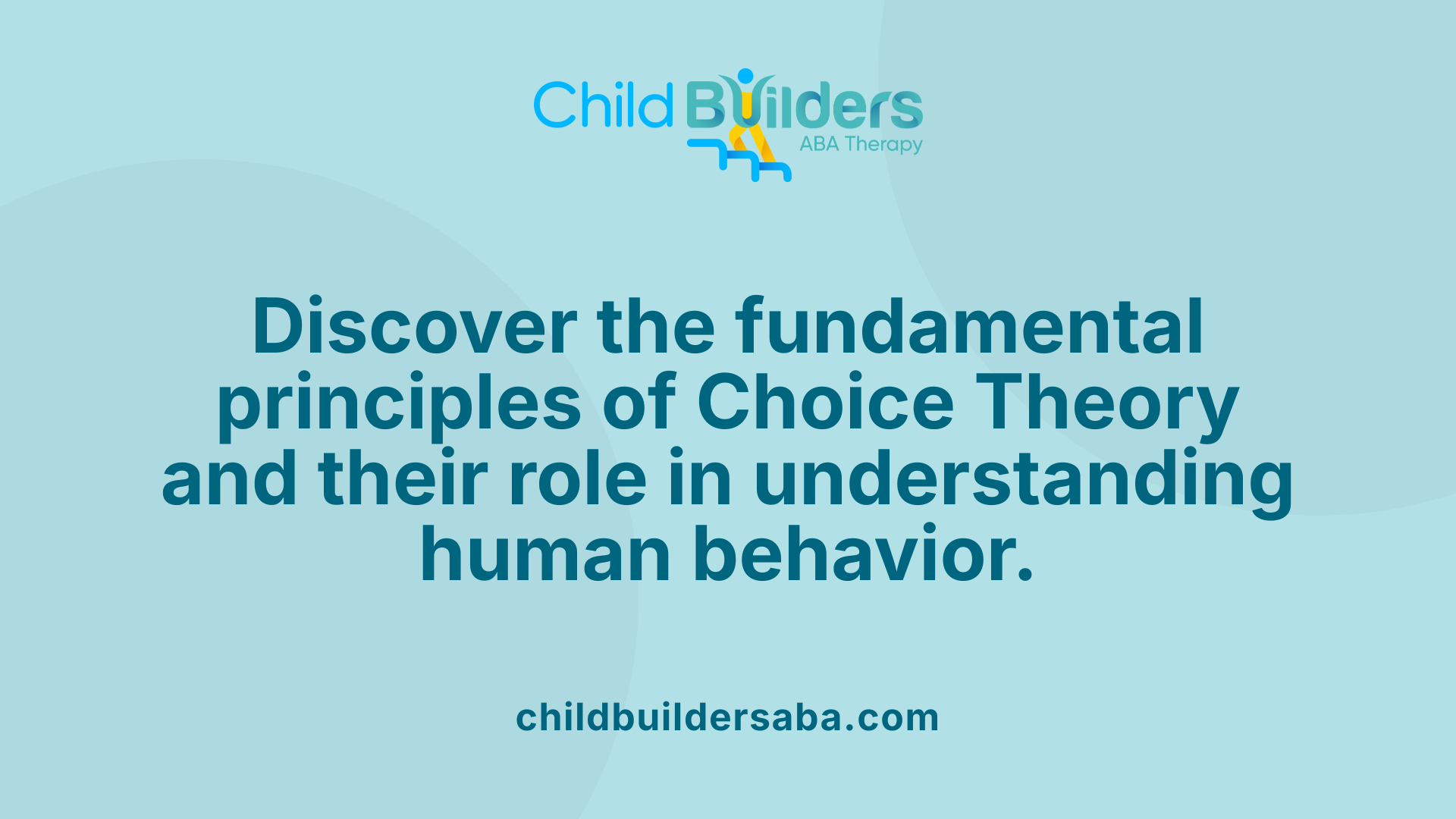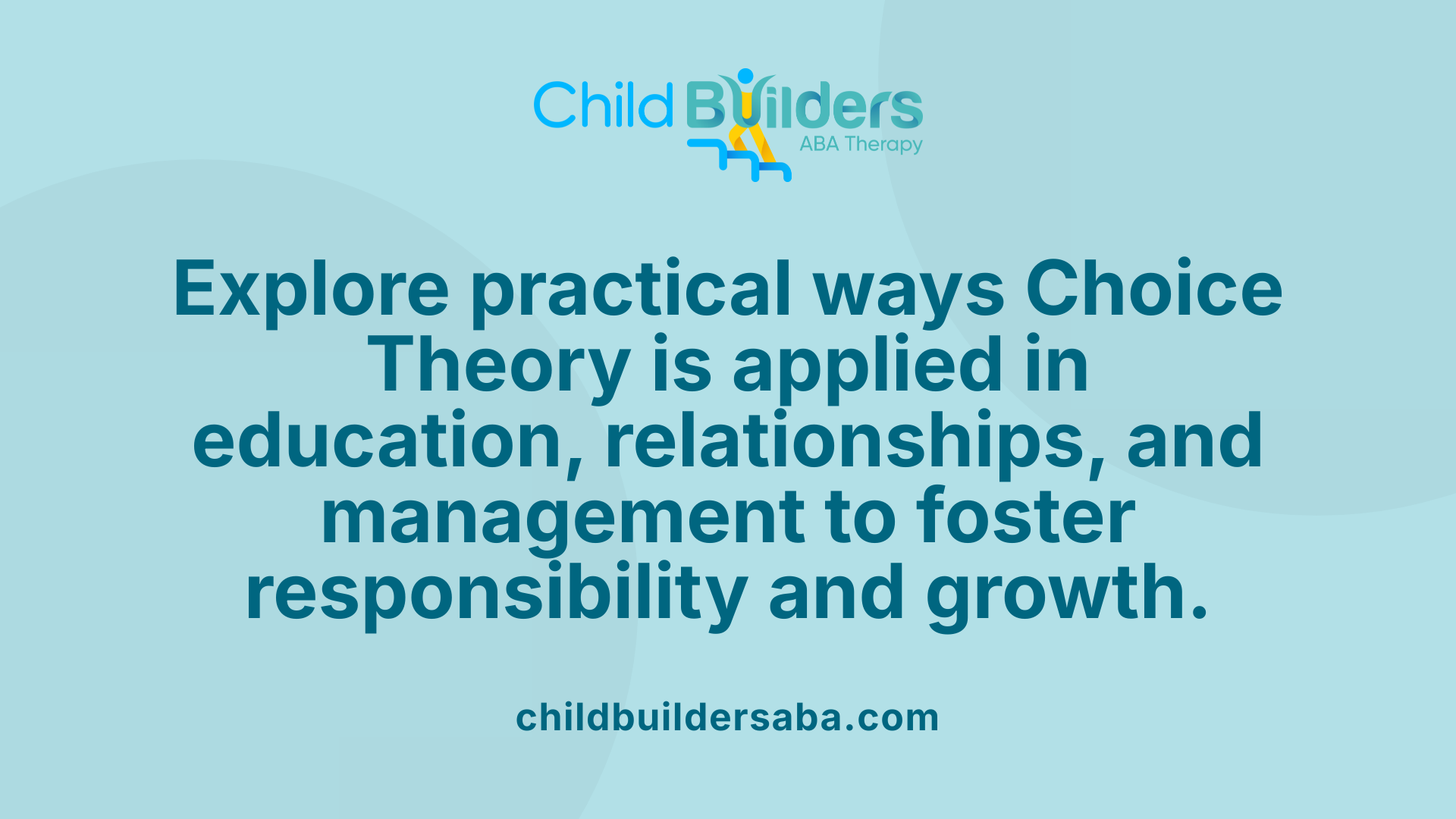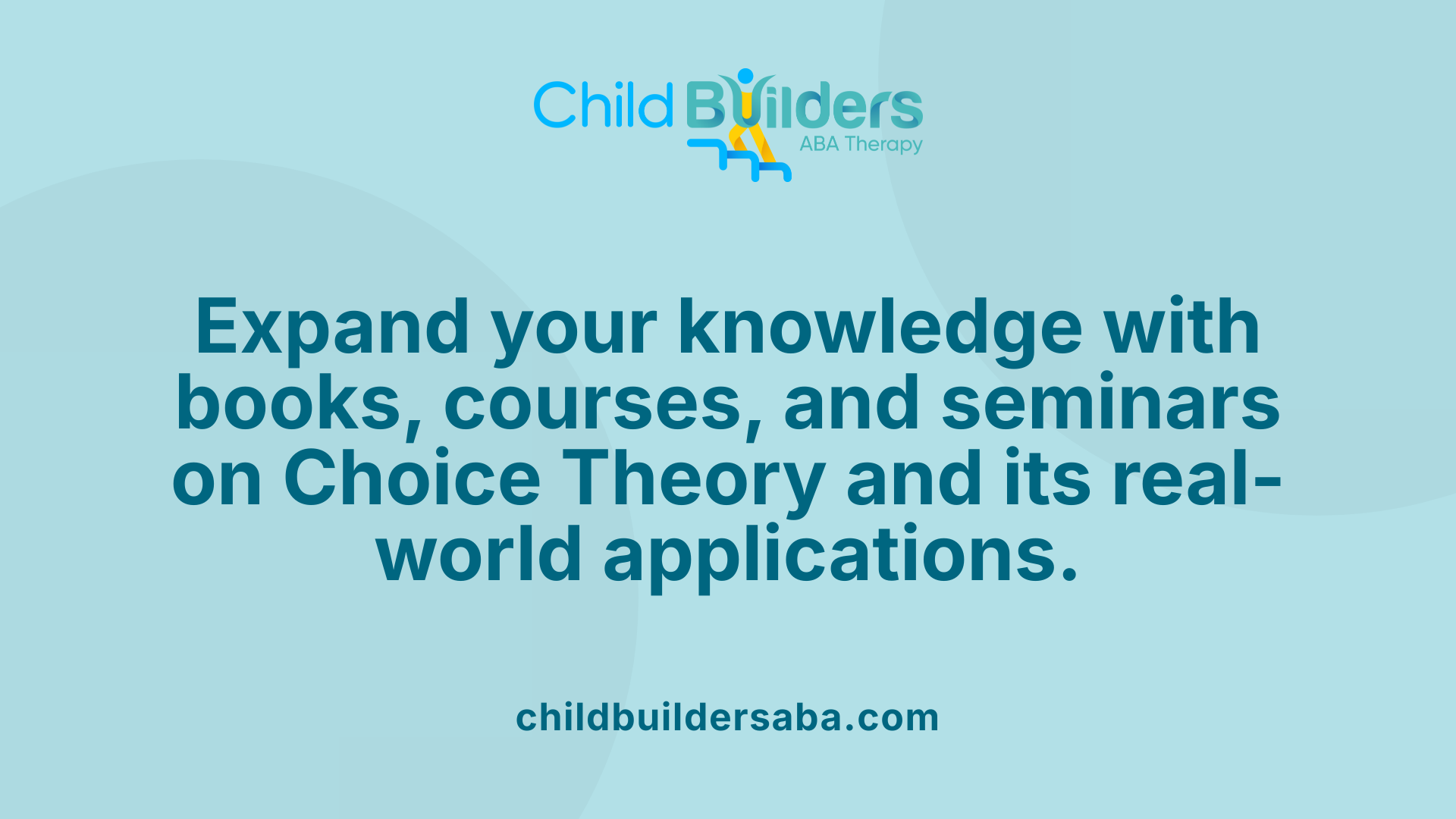What Is Choice Theory?

Introduction to Choice Theory: A New Perspective on Human Behavior
Choice Theory offers a revolutionary way to understand human behavior by emphasizing personal responsibility, internal control, and the innate drive to meet fundamental needs. Developed by William Glasser, this psychological framework shifts the focus from external factors and deterministic models towards understanding how our choices shape our lives and relationships. Recognizing that individuals can only control their own actions, Choice Theory provides practical insights for enhancing mental well-being, improving education, and fostering healthier relationships.
Core Principles Underpinning Choice Theory

What are the fundamental principles of Choice Theory?
Choice Theory is rooted in the belief that individuals only have control over their own behavior, not the behavior of others. It promotes personal responsibility and encourages focusing on the choices we make rather than external circumstances. The theory emphasizes that all human actions are purposeful, motivated primarily by five basic needs: survival, love and belonging, power (or significance), freedom, and fun.
At the heart of Choice Theory lies the concept of the "Quality World," which is a mental repository of images, ideas, and desires that people see as their ideal way of living. These images influence decisions and behaviors as individuals strive to fulfill these internal pictures. The theory also advocates for internal control psychology—meaning that people can influence and change their acting and thinking directly, although feelings and physiology are less directly controllable.
Furthermore, Choice Theory emphasizes the importance of nurturing respectful, supportive relationships. To foster positive interactions, it introduces the Seven Caring Habits—supporting, encouraging, listening, accepting, trusting, respecting, and negotiating differences—and discourages the Seven Deadly Habits like criticizing, blaming, and threatening.
What is Choice Theory in psychology?
Developed by William Glasser, Choice Theory explains human behavior as the result of individual choices driven by innate needs. It asserts that all behavior aims to meet these five essential needs: survival, love and belonging, power, freedom, and fun.
According to Glasser, individuals are responsible for their actions and possess the ability to control their acting and thinking components. These are the most observable and manageable parts of behavior, whereas feelings and physiological responses are influenced indirectly. The "Quality World" functions as a guide, portraying the life each person desires, which drives decision-making.
A distinctive aspect of the theory is its focus on internal control rather than external control—meaning that people are more successful and fulfilled when they focus on managing their own behaviors and choices. This perspective helps reduce destructive habits, enhance relationships, and promote emotional health. The theory also emphasizes the importance of understanding and meeting one's needs in healthy ways, fostering emotional resilience and a sense of personal agency.
In practice, Choice Theory provides a framework for therapy, education, and personal development that prioritizes conscious decision-making and cultivating supportive relationships, ultimately helping individuals lead more satisfying and authentic lives.
Additional insights on the basic needs and concepts
| Concept | Description | Relevance in Choice Theory |
|---|---|---|
| Basic Human Needs | Survival, love & belonging, power, freedom, fun | These are the fundamental drives behind all behavior. |
| The Quality World | A mental 'picture album' of desires that fulfill needs | Guides behavior toward achieving personal satisfaction. |
| Perceived World | An individual's subjective interpretation of reality | Shapes how needs are perceived and pursued. |
| Total Behavior | Comprises acting, thinking, feeling, physiology | Emphasizes that behavior involves all these components, with acting and thinking most directly controllable. |
| Axioms of Choice Theory | Principles such as control over only one's behavior | Serve as foundational rules that explain human actions and interactions. |
Understanding these principles helps clarify why Choice Theory advocates for personal responsibility, self-control, and healthy relationships as pathways to a more satisfying life.
Historical Development and Foundational Concepts
Introduction of Reality Therapy by Dr. Glasser
Dr. William Glasser introduced Reality Therapy in 1965 as a new approach to counseling and psychological treatment. It was grounded in the principles of personal responsibility, emphasizing that individuals have control over their behavior and their lives. Reality Therapy focuses on the present, helping clients to take responsibility for their actions and make better choices to meet their needs.
Development into a comprehensive Choice Theory
Over the years, Reality Therapy expanded into what is now known as Choice Theory. This evolution brought a broader understanding of human behavior, integrating concepts like the 'Total Behavior' model and the significance of internal control. Choice Theory shifted the focus from external pressures and consequences to internal motivation and decision-making, making it applicable across various fields such as education, management, and mental health.
Evolution of key concepts such as Total Behavior and the Basic Needs
A central component of Choice Theory is 'Total Behavior,' which includes acting, thinking, feeling, and physiology. Glasser noted that while acting and thinking are within our control, feelings and physiological responses are influenced indirectly. The theory also emphasizes five basic human needs: survival, love and belonging, power (or significance), freedom, and fun. These needs drive human behavior and shape our perceptions and choices.
The role of the 10 Axioms and the 'Quality World'
Choice Theory is structured around the Ten Axioms, fundamental principles that describe human behavior. Among these, a core idea is that individuals can only control their own behavior, which is made up of acting, thinking, feeling, and physiology. The 'Quality World' forms a mental 'picture album' of what individuals find most valuable—relationships, possessions, and beliefs—that motivate behavior. People constantly compare their 'Quality World' with their 'Perceived World'—their subjective view of reality—leading to feelings of satisfaction or dissatisfaction.
Integration of Choice Theory into various fields like psychology, education, and management
The versatility of Choice Theory has led to its adoption across diverse areas. In education, it promotes student responsibility, active engagement, and improved behavior by focusing on choice and internal motivation. In management, it fosters healthy relationships and effective communication. Psychologically, the theory offers tools for understanding and resolving personal dissatisfaction and relationship issues. Its emphasis on internal control and personal responsibility provides a foundation for fostering healthier, more authentic connections in all areas of life.
| Concept | Description | Application Fields |
|---|---|---|
| Reality Therapy | Practical counseling focusing on present behavior, responsibility, and choice | Counseling, Psychology |
| Total Behavior | Acting, thinking, feeling, physiology—interconnected components of behavior | Psychology, Education |
| Basic Needs | Survival, love & belonging, power, freedom, fun | Psychology, Education, Management |
| The 'Quality World' | Mental images of what individuals value most, driving behavior | Psychology, Personal Development |
| Ten Axioms | Fundamental principles about control, behavior, and motivation | Psychology, Education, Management |
This evolution from Reality Therapy to Choice Theory highlights a shift toward empowering individuals through understanding their innate needs and emphasizing personal choice as the driving force behind human behavior. Its broad applicability continues to influence many domains, advocating for a more human-centered approach to living, learning, and working.
Key Components and Concepts of Choice Theory
The 'Quality World' and the 'Perceived World'
At the center of Choice Theory is the idea of the 'Quality World.' This mental 'picture album' contains images of our desires, beliefs, and values related to meeting our basic needs. It represents our personal vision of an ideal life, where our fundamental needs are fulfilled.
Our perception of reality, known as the 'Perceived World,' is subjective and shaped by sensory information. Each individual interprets the world through personal filters such as culture, experiences, and beliefs. This creates a unique perception of reality for everyone.
The interaction between these two worlds influences our emotions and behaviors. When our perceived world aligns with our quality world, we experience satisfaction and happiness. When they are mismatched, feelings of dissatisfaction, frustration, or dissatisfaction emerge.
Understanding this dynamic helps us become more aware of why we behave the way we do, and it opens pathways for making deliberate choices to meet our needs.
Total Behavior: acting, thinking, feeling, physiology
A core idea in Choice Theory is the concept of total behavior, which comprises four interconnected components:
- Acting
- Thinking
- Feeling
- Physiology
These components are constantly occurring and influence each other. Importantly, individuals have the most control over acting and thinking, which can be consciously altered.
Feelings and physiology, although less directly controllable, are still influenced by our actions and thoughts. For example, choosing to think positively or to act kindly can affect our emotional state and physical responses.
This understanding emphasizes personal responsibility. By changing our acting and thinking, we can influence how we feel and how our bodies respond, promoting healthier behavior patterns.
The Comparing Place and How it Influences Feelings
The concept of the 'Comparing Place' is essential to understanding motivation in Choice Theory. It refers to the process where our brain compares what we desire in our 'Quality World' with what we perceive we currently have in our 'Perceived World.'
This comparison creates feelings. A close match results in satisfaction and happiness, while a significant mismatch causes dissatisfaction or disappointment.
For example, if someone values close relationships and perceives their relationships to be fulfilling, they feel happy. If there is a perceived lack of connection, they may feel lonely or frustrated.
By becoming aware of this comparison process, individuals can take active steps to adjust either their perceptions or their behaviors to improve their sense of satisfaction.
The Seven Caring Habits and the Seven Deadly Habits
Choice Theory promotes improving relationships through specific behaviors. The 'Seven Caring Habits' foster positive interactions and include:
- Supporting
- Encouraging
- Listening
- Accepting
- Trusting
- Respecting
- Negotiating differences
Conversely, the 'Seven Deadly Habits' undermine relationships and contribute to conflict and dissatisfaction:
- Criticizing
- Blaming
- Complaining
- Nagging
- Threatening
- Punishing
- Bribing
Replacing harmful habits with caring ones fosters healthier connections, whether in family, school, or workplace settings.
The Ten Axioms of Choice Theory
The foundation of Choice Theory is outlined in its Ten Axioms, which include principles that guide understanding of human behavior:
- We can only control our own behavior.
- All behavior is total behavior, composed of acting, thinking, feeling, and physiology.
- Behavior is a choice.
- Our actions are motivated by the desire to meet one or more of the five basic needs.
- The only person whose behavior we can control is our own.
- Our perception creates our reality.
- Psychological problems stem mainly from relationship issues, not mental illness.
- We have the power to change our behavior by changing our acting and thinking.
- Fulfilling needs leads to satisfaction; failure leads to dissatisfaction.
- Relationships are central to human happiness.
These axioms serve as guiding principles that help individuals take responsibility for their behavior and understand its purpose.
| Component | Description | Purpose |
|---|---|---|
| Quality World | Mental images of desires and values | Guides behavior towards fulfilling needs |
| Perceived World | Personal interpretation of reality | Shapes our responses and feelings |
| Total Behavior | Acting, thinking, feeling, physiology | The sum of actions and internal states |
| The Comparing Place | Evaluation of desires versus perceptions | Determines satisfaction or dissatisfaction |
By understanding these components, individuals can make intentional choices aligned with their values and needs, fostering well-being and improved relationships.
Applications of Choice Theory in Different Contexts

How is Choice Theory applied in educational and personal development contexts?
In education, Choice Theory shifts the focus from external control to student responsibility and autonomy. Teachers use its principles to encourage learners to take ownership of their choices, leading to increased motivation and better academic outcomes. For example, students may choose their assignments or classroom activities, promoting engagement and self-direction. This approach reduces behavioral issues by fostering a sense of responsibility and capability.
On a personal level, Choice Theory emphasizes understanding and satisfying the five basic needs—survival, love and belonging, power, freedom, and fun—through conscious decision-making. Individuals are encouraged to recognize their responsibilities and control over their actions, which helps develop emotional resilience and goal setting. By focusing on controllable behaviors rather than external circumstances, people can create more fulfilling and balanced lives.
Overall, applying Choice Theory empowers individuals to make deliberate choices that influence their learning and personal growth, fostering responsibility, motivation, and emotional stability.
What practical examples demonstrate Choice Theory in action?
A practical illustration of Choice Theory is how people handle everyday challenges. For instance, when faced with unexpected bank charges, instead of feeling helpless or blaming the bank, an individual might choose to address the problem directly—calling customer service or organizing their finances. This approach exemplifies taking control over their reaction, prioritizing actions that meet their needs for security and competence.
In relationships, individuals might choose to listen and support rather than criticize or blame, aligning with the Seven Caring Habits. In workplaces, managers might promote autonomy and responsibility by allowing employees to set goals and choose methods to achieve them. These examples demonstrate the core idea that behavior is a series of choices aimed at fulfilling intrinsic needs.
By recognizing their power to influence outcomes actively, individuals and organizations can foster a positive environment centered on responsible decision-making and self-control.
What is the focus of Choice Theory in educational settings?
In schools, Choice Theory highlights the importance of building relationships based on mutual respect and understanding. Educators encourage students to recognize that their behavior is a choice driven by their needs. When students understand this, they become more responsible for their actions and motivated to develop self-control.
Classroom strategies include giving students options in their learning, which boosts engagement. For instance, allowing students to select topics or projects aligns with their interests, satisfying needs for fun and autonomy. This responsibility reduces disruptive behavior while increasing motivation and academic success.
Furthermore, Choice Theory advocates for a caring classroom environment where teachers focus on fostering positive relationships. These connections help students feel valued, fulfilling their need for belonging, and create a safe space for growth.
In summary, the approach emphasizes responsibility, self-awareness, and relationship-building, aiming to develop self-motivated and responsible learners who understand the purpose behind their actions.
Resources and Further Learning Opportunities

Where can I learn more about Choice Theory and find relevant resources?
To expand your understanding of Choice Theory and access a variety of learning materials, start by exploring William Glasser’s writings. His books are considered the primary sources for understanding the foundational concepts of Choice Theory. Notable titles include "Choice Theory: A New Psychology of Personal Freedom," which introduces the core principles, and "Choice Theory Classroom," which applies these ideas in education.
In addition to books, numerous online summaries, educational websites, and articles provide overviews of Choice Theory’s concepts. These resources are often tailored for educators, counselors, and individuals interested in personal development. Academic libraries and bookstores also carry works related to Reality Therapy, Glasser’s practical approach to applying Choice Theory in real-world settings.
Attending workshops, seminars, and online courses dedicated to Choice Theory can significantly deepen your understanding. These events often feature experienced trainers and can provide practical skills for applying the theory in counseling, education, management, and personal relationships.
Below is a table summarizing some of the most accessible resources and learning opportunities:
| Resource Type | Examples | Details |
|---|---|---|
| Books | "Choice Theory" by William Glasser "Choice Theory in the Classroom" |
Foundational texts offering comprehensive insights |
| Websites & Articles | Educational platforms like Glasser Institute website Online summaries |
Easy-to-understand overviews and updates |
| Workshops & Seminars | Certified Reality Therapy training Choice Theory workshops |
Hands-on learning with experts |
| Online Courses | Web-based programs offered by Glasser International | Flexible learning options for professionals and students |
Exploring these resources will help you understand not only the theory’s core principles but also how to apply them effectively in various life domains.
Embracing a New Paradigm for Human Behavior
Choice Theory presents a transformative approach to understanding human motivation and behavior. By recognizing that individuals are responsible for their choices and that all behavior serves the purpose of fulfilling basic needs, the theory empowers people to take control of their lives, improve relationships, and foster personal growth. With its focus on internal control, respectful communication, and deliberate decision-making, Choice Theory offers practical tools for educational, personal, and professional settings. As a comprehensive psychological framework rooted in accountability and understanding, it encourages us to move beyond external influence and embrace personal responsibility for a more fulfilling, connected life.
References
- What Is Choice Theory? - GIFCT - William Glasser Institute
- Glasser's choice theory - Wikipedia
- Choice Theory Basics | learnonline - UniSA
- Quickstart Guide to Choice Theory - GIFCT - William Glasser Institute
- What is Choice Theory? - Applied Behavior Analysis Programs Guide
- Choice Theory
- Choice theory: A new psychology of personal freedom. - APA PsycNET
- Choice Theory - William Glasser Institute Ireland
- [DOC] [DOC] Choice Theory Basics by Dr. William Glasser
- Choice Theory: Can Our Choices Shape Our Well-Being?





.jpg)































































































